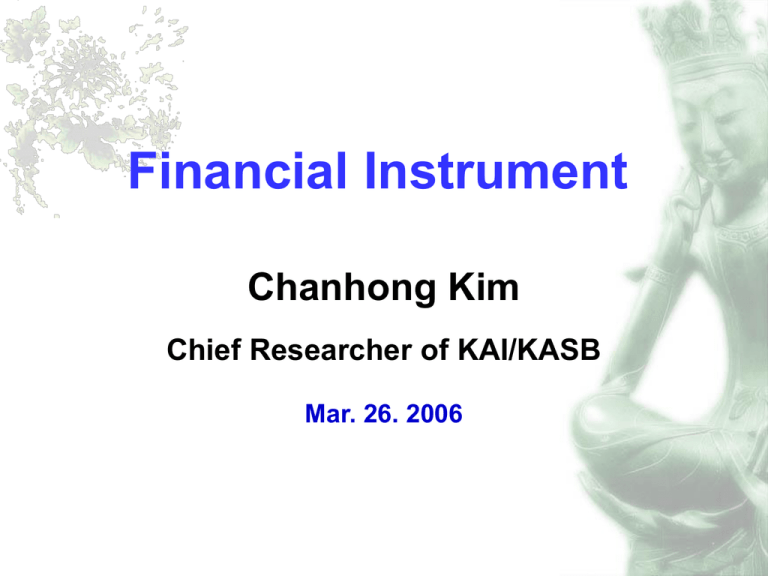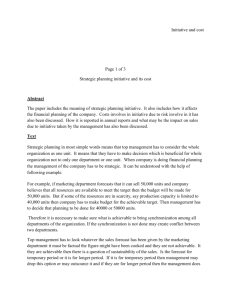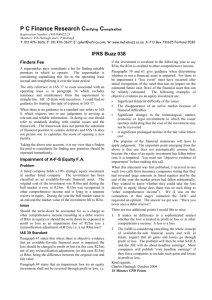Current Accounting Reforms in Korea
advertisement

Financial Instrument Chanhong Kim Chief Researcher of KAI/KASB Mar. 26. 2006 Disclaimer The views expressed in this presentation are those of the speaker. Official positions of the KAI/KASB are determined only after extensive due process and deliberation. Topics Asset Transfer with guarantee or subordinated retained interest Partial derecognition Regular way purchase or sale Impairment of AFS equity FI Part of Cash Flows? Reclassification of Held for Trading FI Relationship among Financial Instrument & etc. Subsequent Measurement of Loan Commitments Derivative that is a Financial Guarantee Contract Timing of Initial Recognition Asset Transfer with guarantee or subordinated retained interest The effect of guarantee, etc. on derecognition Provisions of IAS 39 - Par.16(b) : when an entity transfers ……… the rights to 90 per cent of the cash flows from a group of receivables, but provides a guarantee to compensate the buyer for any credit losses up to 8 per cent of the principal amount of the receivables, paragraphs 17-23 are applied to a financial asset (or a group) in its entirety. - AG52 : when an entity transfers the rights to a fully proportionate 90 per cent of the cash flows from a portfolio of prepayable loans, but subordinates its retained interest to provide credit enhancement to the transferee for credit losses, paragraphs 17-23 are applied to a part of a financial asset (or a part of a group). Asset Transfer with guarantee or subordinated retained interest Questions (1) The detailed meaning of the transactions set out in par.16⒝ and AG52, and the difference between those sample transactions? Is it appropriate in each situation? (2) Should all guarantee result in ‘continuing involvement’? It is not clear from AG48(a), AG51, etc. (3) When guarantee results in ‘continuing involvement’, should the consideration received due to guarantee consist associated liability? Partial derecognition Accounting for debt instrument with detachable interest-only strip. Provisions of IAS 39 - Par.16(a)(i) : The part comprises only specifically identified cash flows from a financial asset (or a group). For example, when an entity enters into an interest rate strip whereby the counterparty obtains the right to the interest cash flows, but not the principal cash flows from a debt instrument, paragraphs 17-23 are applied to the interest cash flows. - Par.27,28 : The previous carrying amount(including cummulative gain or loss in equity) of the larger financial asset shall be allocated between the part that continues to be recognised and the part that is derecognised, based on the relative fair values of those parts on the date of the transfer. Partial derecognition Accounting for debt instrument with detachable interest-only strip. (example) - Detachable government bond (treasury security) - More than 10 years’ maturity - Can transfer interest only strip from bond - FV of entire bond may not equal to sum of FV of Principal and Interest FVs are all available Partial derecognition Questions (1) On initial recognition, Can the owner of bond recognize assets for Principal and Interest strip separately? - Bond is composed of two different CFs. cf.) Owner of bond with detachable stock right recognize debt security and equity security separately. (2) In case IAS 39 should be applied, what the entity should do when it repurchase interest-only strip few years after it transferred (derecognized). (3) In case IAS 39 should be applied, how the amount of related deferred income tax asset or liability due to fair value change be allocated to the part sold and the part that continues to be recognized. Regular way purchase or sale Settlement date Accounting. - Appropriate logically? - meaning of ‘within the time frame established generally’ Provisions of IAS 39 - Par.9 : A regular way purchase or sale is a purchase or sale of a financial asset under a contract whose terms require delivery of the asset within the time frame established generally by regulation or convention in the marketplace concerned. - AG56 : …… an entity accounts for any change in the fair value of the asset to be received during the period between the trade date and the settlement date in the same way as it accounts for the acquired asset. In other words, the change in value is not recognised for assets carried at cost or amortised cost; it is recognised in profit or loss for assets classified as financial assets at fair value through profit or loss; and it is recognised in equity for assets classified as available for sale. Regular way purchase or sale Questions (1) Is settlement date accounting appropriate? - Regular way transaction is not different from spot transaction. - When measured at fair value, both accounting (Settlement date & Trade date) brings out substantially the same results - When measured at fair value, profit or loss is recognized on unrecognized asset. (2) Is transaction in OTC a regular way transaction? (3) Can ‘T+30’ be ‘within the time frame established generally’ Regular way purchase or sale Questions (4) Conflict between par.57 and par.59 ? If an entity recognises financial assets using settlement date accounting (see paragraph 38 and Appendix A paragraphs AG53 and AG56), any change in the fair value of the asset to be received during the period between the trade date and the settlement date is not recognised for assets carried at cost or amortised cost (other than impairment losses). …… – par. 57 : A financial asset or a group of financial assets is impaired and impairment losses are incurred if, and only if, there is objective evidence of impairment as a result of one or more events that occurred after the initial recognition of the asset (a 'loss event') and that loss event (or events) has an impact on the estimated future cash flows of the financial asset or group of financial assets that can be reliably estimated. - par. 59 : Impairment of AFS equity FI IFRIC Draft Interpretation D18 - Should general measurement principle in IAS34 (year to date basis) be Over-ridden? Provisions of IAS 39 - Par.61 : … A significant or prolonged decline in the fair value of an investment in an equity instrument below its cost is also objective evidence of impairment. - Par.68 : loss amount = (cost – FV) – loss recognized before Impairment of AFS equity FI Comments (1) Impairment loss is measured using FV. (2) The fair value of AFS reflects not only entity specific factors but also market situations. (3) Measured impairment loss may frequently contain the effect from noisy factors (amount measured due to normal fluctuations of market) that are not directly related to impairment of specific AFS. (4) An impairment loss recognized in a previous interim period should not affect the measurement basis for interim reporting, which is a ‘year to date basis’. (5) In case the position of D18 is still to be maintained, IAS34 and/or IAS39 need to be revised rather than using Interpretation. Part of Cash Flows? Meaning of Part of CF. Provisions of IAS 39 - Par.16(b) : … when an entity transfers (i) the rights to the first or the last 90 per cent of cash collections from a financial asset (or a group of financial assets) … paragraphs 17-23 are applied in its entirety - BC53 and/or other paragraph : (a) only specifically identified cash flows from a financial asset (or a group of similar financial assets); (b) only a fully proportionate (pro rata) share of the cash flows from a financial asset (or a group …); or (c) only a fully proportionate (pro rata) share of specifically identified cash flows from a financial asset (or a group) Part of Cash Flows? Questions (1) Assume debt security that pays $100 at each year end for 5 years. What is the meaning of first or the last 90 per cent of cash collections in par.16(b) (2) Assume debt security that has principal amount of $1,000 and pays cash interest of $50 per year. - In case the holder that has portfolio of similar debt securities transferred the right to 90% of principal and 70% of interest payment, then…? Reclassification of Held for Trading FI Reclassification of held for trading FI is prohibited. Is it appropriate? Provisions of IAS 39 - Par.9 : A financial asset or financial liability is classified as held for trading if it is: (i) acquired or incurred principally for the purpose of selling or repurchasing it in the near term; (ii) part of a portfolio of identified financial instruments that are managed together and for which there is evidence of a recent actual pattern of short-term profit-taking; or (iii) a derivative(except for a derivative that is a financial guarantee contract or a designated and effective hedging instrument). - Par.50 : An entity shall not reclassify a financial instrument into or out of the fair value through profit or loss category while it is held or issued Reclassification of Held for Trading FI Questions Financial instrument as held for trading may not meet the definition of as held for trading in par. 9 of IAS 39 through changes in circumstances while it is held or issued. For example, pledging as a collateral, delisting or transaction restrictions by regulation etc. It is considered to be appropriate that a financial instrument as held for trading pledged as a collateral can not be reclassified, but a financial instrument as held for trading under delisting or transaction restrictions by regulation etc. can be reclassified. IAS 39 par. 50 prohibits a financial instrument as held for trading to be reclassified. Is it appropriate? If yes, what is the reason of such a provision? Relationship among Financial Instrument & etc. Financial instrument, derivative and other contract (contracts) vs. financial asset and financial liability(or equity instrument) Financial instrument and other contract vs. derivative Provisions of IAS 32 and IAS 39 - Inference from par. 11 of IAS 32 : financial instrument, derivative and other contract are contracts and financial asset and financial liability(or equity instrument) are acquired or incurred from those contracts. - Inference from par. 9 of IAS 39 : FI OC ① ② ④ Scope ③ ※ financial instrument : ① + ② ⑤ other contract : ④ derivative : ① + ④ scope exception : ③ + ⑤ Outside Relationship among Financial Instrument & etc. Question ⑴ Is the above inferences or below (⑵와 ⑶) understandings appropriate? If yes, it seems more appropriate to include the above inferences or below understandings in the Appendix of IAS 39 to make users understand better? Understandings ⑵ With their meanings mixed, financial instrument and derivative are used in IAS 39 as contract or financial asset and financial liability ⑶ Par. 9 of IAS 39 defines a derivative as a financial instrument or other contract within the scope of IAS 39 with all three of designated characteristics. The reason is that scope provisions are located before definition provisions in IAS 39. Subsequent Measurement of Loan Commitments Subsequent measurement of commitments to provide a loan at a below-market interest rate Provision of IAS 39 - Par.47⒟ : After initial recognition, an issuer of such a commitment shall (unless paragraph 47(a) applies) measure it at the higher of: (i) the amount determined in accordance with IAS 37; and (ii) the amount initially recognised (see paragraph 43) less, when appropriate, cumulative amortisation recognised in accordance with IAS 18. Question what is the detailed accounting treatment of Par. 47⒟ of IAS 39 ? In particular, that of Par.47⒟ (ii) ? Derivative that is a Financial Guarantee Contract Does a derivative that is a financial guarantee contract exist ? Provisions of IAS 39 - Par.9 : A financial asset or financial liability is classified as held for trading if it is: …… (iii) a derivative(except for a derivative that is a financial guarantee contract or a designated and effective hedging instrument). - Par.9 : A financial guarantee contract is a contract that requires the issuer to make specified payments to reimburse the holder for a loss it incurs because a specified debtor fails to make payment when due in accordance with the original or modified terms of a debt instrument. - AG4⒝ : A guarantee that requires payments in response to changes in a specified credit rating or credit index is not a financial guarantee contract and insurance contract but a derivative. Derivative that is a Financial Guarantee Contract Question - Does a derivative that is a financial guarantee contract exist considering financial guarantee contract defined in IAS 39? - If yes, what are those examples ? Timing of Initial Recognition Meaning of ‘when, and only when, the entity becomes a party to the contractual provisions of the instrument’ in application? Provision of IAS 39 - Par.14 : An entity shall recognise a financial asset or a financial liability on its balance sheet when, and only when, the entity becomes a party to the contractual provisions of the instrument. (See paragraph 38 with respect to regular way purchases of financial assets.) Timing of Initial Recognition Question - What is the meaning in applying of ‘when, and only when, the entity becomes a party to the contractual provisions of the instrument’ ? - It seems more appropriate to provide the specific criteria on the timing of initial recognition, like a derecognition criteria in IAS 39, instead of presenting some examples of applying par. 14 of IAS 39. - For example, an entity shall recognise the financial asset as its asset when it can control a financial asset Thank You




